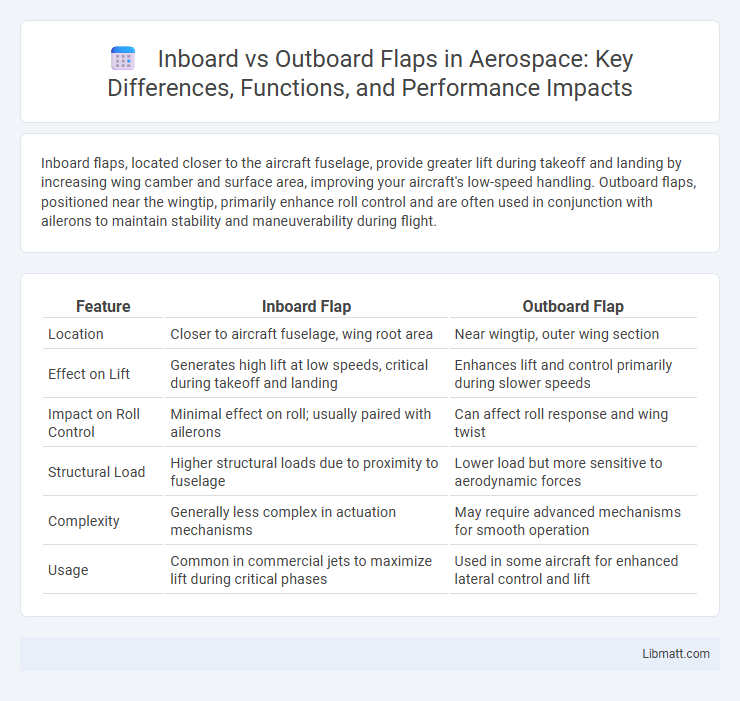Inboard flaps, located closer to the aircraft fuselage, provide greater lift during takeoff and landing by increasing wing camber and surface area, improving your aircraft's low-speed handling. Outboard flaps, positioned near the wingtip, primarily enhance roll control and are often used in conjunction with ailerons to maintain stability and maneuverability during flight.
Table of Comparison
| Feature | Inboard Flap | Outboard Flap |
|---|---|---|
| Location | Closer to aircraft fuselage, wing root area | Near wingtip, outer wing section |
| Effect on Lift | Generates high lift at low speeds, critical during takeoff and landing | Enhances lift and control primarily during slower speeds |
| Impact on Roll Control | Minimal effect on roll; usually paired with ailerons | Can affect roll response and wing twist |
| Structural Load | Higher structural loads due to proximity to fuselage | Lower load but more sensitive to aerodynamic forces |
| Complexity | Generally less complex in actuation mechanisms | May require advanced mechanisms for smooth operation |
| Usage | Common in commercial jets to maximize lift during critical phases | Used in some aircraft for enhanced lateral control and lift |
Introduction to Aircraft Flap Systems
Aircraft flap systems are critical lift-enhancing devices installed on the wing trailing edges to improve low-speed handling and reduce stall speeds. Inboard flaps, positioned closer to the aircraft fuselage, typically provide higher lift increases during takeoff and landing, while outboard flaps extend toward the wingtip to enhance roll control and maintain stability. The combination and positioning of inboard and outboard flaps optimize aerodynamic performance and safety across different flight phases.
Defining Inboard and Outboard Flaps
Inboard flaps are located closer to the aircraft fuselage and typically provide higher lift during takeoff and landing by increasing the wing camber near the root. Outboard flaps are positioned near the wingtip, enhancing control and reducing stall risk by managing airflow at the wing's outer sections. Understanding the distinct aerodynamic roles of inboard and outboard flaps can optimize your aircraft's performance in critical flight phases.
Key Functions of Inboard Flaps
Inboard flaps primarily enhance lift during takeoff and landing by increasing the wing's camber and surface area, allowing lower stall speeds and shorter runway requirements. These flaps provide better lift distribution near the aircraft's fuselage, improving overall stability and control. Their design helps reduce drag compared to outboard flaps, making them more efficient for specific phases of flight.
Role of Outboard Flaps in Lift Generation
Outboard flaps significantly enhance lift by increasing the wing's camber and surface area during takeoff and landing, improving low-speed performance and reducing stall speed. Positioned near the wingtip, they contribute to roll stability by balancing aerodynamic forces and minimizing adverse yaw. Their deployment allows for smoother airflow over the wing, maximizing lift without compromising structural integrity.
Comparative Analysis: Inboard vs Outboard Flap Performance
Inboard flaps typically generate higher lift at lower speeds due to their position closer to the aircraft fuselage, enhancing stability during takeoff and landing phases. Outboard flaps provide improved roll control and reduced adverse yaw by affecting the outer wing sections, which are critical for maneuverability and overall aerodynamic efficiency. Comparative studies show inboard flaps excel in lift augmentation and structural advantages, while outboard flaps offer superior control and responsiveness, influencing flap selection based on specific flight performance requirements.
Impact on Aircraft Stability and Control
Inboard flaps, positioned closer to the aircraft fuselage, generally enhance stability by reducing wingtip vortices and maintaining better airflow over the ailerons, which improves roll control during slow flight. Outboard flaps, located near the wingtips, can increase lift but may disrupt aileron effectiveness, potentially leading to reduced roll authority and less precise maneuvering. The choice between inboard and outboard flaps influences the balance between increased lift and sustained control, affecting overall aircraft stability and handling characteristics during critical phases like takeoff and landing.
Design Considerations for Flap Placement
Inboard flaps are typically positioned closer to the fuselage, offering better lift generation at lower speeds and enhanced control during takeoff and landing. Outboard flaps, located farther along the wing, improve roll control and delay tip stall but may introduce more aerodynamic complexity and structural stress. Your choice of flap placement directly affects aerodynamic efficiency, structural design, and overall aircraft performance in various flight phases.
Efficiency and Fuel Consumption Differences
Inboard flaps generally improve aircraft lift more efficiently by generating higher lift coefficients near the wing root, which reduces induced drag and enhances fuel economy during takeoff and landing phases. Outboard flaps, positioned near the wingtip, can increase drag due to vortices and may lead to slightly higher fuel consumption compared to inboard flaps. Your aircraft's overall fuel efficiency benefits more from inboard flaps because they optimize lift-to-drag ratios better during critical flight segments.
Maintenance and Operational Implications
Inboard flaps typically require more complex maintenance due to their proximity to the fuselage and integration with control systems, leading to increased inspection times and potential access difficulties. Outboard flaps, located near the wingtips, generally experience higher aerodynamic loads but are easier to access for routine maintenance, resulting in lower downtime. Operationally, inboard flaps provide better lift augmentation at lower speeds, influencing maintenance schedules due to their frequent use during takeoff and landing phases.
Conclusion: Choosing Between Inboard and Outboard Flaps
Inboard flaps offer improved lift and better control at lower speeds, making them ideal for aircraft requiring short takeoff and landing capabilities. Outboard flaps enhance roll control and reduce wing structural stress, benefiting high-speed and aerobatic performance. Your choice between inboard and outboard flaps should align with the specific aerodynamic requirements and operational priorities of your aircraft.
Inboard flap vs Outboard flap Infographic

 libmatt.com
libmatt.com